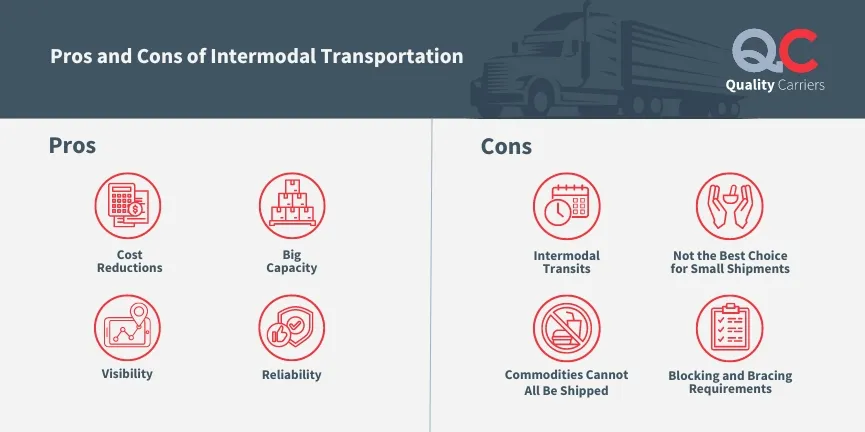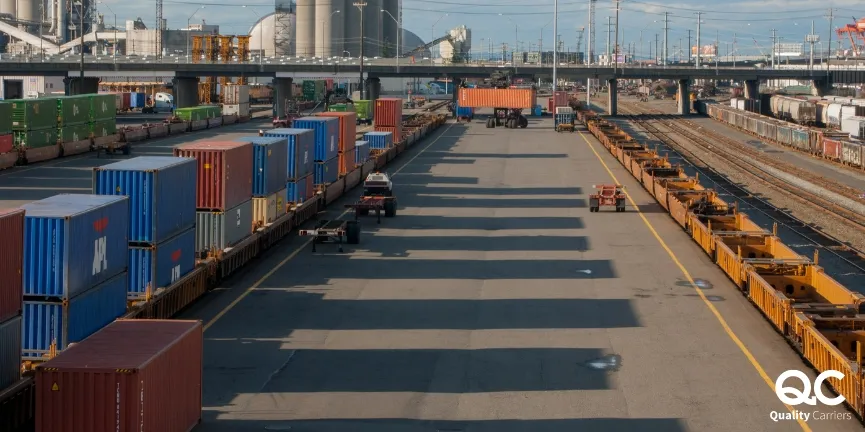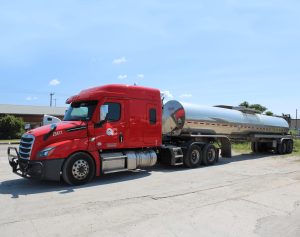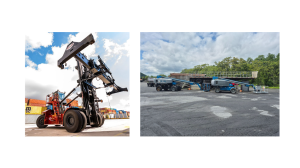Intermodal transportation is essential to the global logistics industry. It provides a flexible and efficient way to move goods across vast distances. It combines multiple modes of transport, such as trucks, trains, ships, and planes. It offers a streamlined approach to delivering products efficiently and cost-effectively.
In this blog, we’ll explore how intermodal transportation works and the advantages it provides to businesses.
What is Intermodal Transportation?
Intermodal transportation refers to transporting goods using two or more different modes of transport within a single journey. The cargo is typically moved in standardized containers and easily transferred between trucks, trains, ships, and planes without handling the goods themselves. This approach allows businesses to optimize their logistics operations by combining the cost-efficiency of rail and ship transport with the flexibility of trucks and, when necessary, the speed of air transport.

Pros of Intermodal Transportation
Cost Reductions
Intermodal shipping can significantly reduce transportation costs by utilizing the most economical modes of transport for each leg of the journey. Rail and ship transport are often more cost-effective than long-distance trucking, leading to substantial savings.
Big Capacity
Intermodal transport can handle large volumes of goods, making it ideal for bulk shipments. Standardized containers allow for efficient loading and unloading, maximizing the capacity of each mode of transport.
Visibility
Advanced tracking technologies offer real-time visibility into shipments’ location and status during the entire intermodal journey. This visibility enhances supply chain management and allows businesses to respond quickly to disruptions.
Reliability
Due to its structured nature, intermodal shipping is highly reliable. Each mode of transport operates on fixed schedules, reduces the risk of delays and ensures on-time delivery of goods.
Cons of Intermodal Transportation
Intermodal Transits
Intermodal shipping may involve longer transit times than direct intermodal trucking, mainly if multiple modes are used. Delays can occur during the transfer of goods between modes, which may not be suitable for time-sensitive shipments.
Blocking and Bracing Requirements
Proper blocking and bracing of cargo within containers are essential to prevent shifting during transit. This process is time-consuming and it requires specialized knowledge to ensure the safety of the goods.
Commodities Cannot All Be Shipped
Not all commodities are suitable for intermodal shipping. Perishable goods, hazardous materials, and oversized items may require specialized handling that intermodal services can only sometimes provide.
Not the Best Choice for Small Shipments
Intermodal shipping is typically more cost-effective for large or bulk shipments. However, the costs associated with transferring goods between modes may outweigh the benefits for smaller shipments.
How Does Intermodal Transport Work?
Intermodal transport involves a coordinated process where goods are transferred between different modes of transport to optimize the supply chain. There are two primary types of intermodal transport: international and domestic.
Types of Intermodal Transport
- International Intermodal Transport: This type involves the movement of goods across international borders, typically combining ocean shipping with rail and truck transport. Goods are transported in containers from the point of origin to a port, where they are loaded onto a ship. After crossing the ocean, the containers are unloaded at the destination port and transferred to trucks or trains for final delivery.
- Domestic Intermodal Transport: Domestic intermodal transport occurs within a single country, typically combining truck and rail transport. Containers are moved from the point of origin by truck to a rail yard, where they are loaded onto trains for long-distance transport. Upon reaching the destination rail yard, the containers are returned to trucks for final delivery.
The Process of Intermodal Transport
The intermodal freight transportation process generally involves a sequence of rail, truck, ship, and truck transport. The trucking segment between rail terminals and ocean ports, or drayage, is a specialized service typically managed by experts. Here’s an example of how the intermodal transportation process works:

- Empty Container Delivery to Shipper: An ISO tank filled with liquid chemicals is brought to the shipper’s location by truck, which marks the start of the shipping process.
- Container Loading and Transport to Railyard: Once filled, the ISO tank is loaded onto a truck and transported to the railyard, where it is prepared for further transportation by train.
- Rail Transport to Destination Region: The ISO tank is loaded onto an intermodal train and transported along dedicated intermodal railways to the destination region.
- Final Delivery and Unloading: Upon arrival in the destination region, the ISO tank is transferred to a truck and delivered to the consignee, where the liquid chemicals are unloaded.
- Container Ready for Reuse: After unloading, the ISO tank can be reused for another shipment, allowing the intermodal transportation process to start anew for the next customer and destination.
Conclusion
Intermodal transportation is a powerful tool in the logistics industry, offering a cost-effective, sustainable, and efficient way to move goods across long distances. By integrating intermodal trucking, rail transport, shipping, and sometimes air transport, businesses can leverage the strengths of each mode to optimize their supply chains. With its many benefits, companies preferred intermodal transportation to enhance their logistics operations.
FAQs
Intermodal transport is ideal for large or bulk shipments, non-perishable goods, and items that do not require specialized handling. It may not be suitable for perishable goods, hazardous materials, or small shipments.
Intermodal transportation uses multiple modes of transport with standardized containers that are easily transferable between modes without handling the goods. Multimodal transportation also involves multiple modes but typically under a single contract with one carrier responsible for the entire journey, which may include direct cargo handling.
Intermodal transportation can be a good option for e-commerce businesses, particularly for moving large inventory volumes across long distances. However, there may be better choices for last-mile delivery or time-sensitive orders, where speed and flexibility are critical.
Yes, intermodal transportation can be used for hazardous materials, but it requires strict compliance with safety regulations and specialized containers designed for dangerous goods. Each mode of transport involved must also meet the necessary safety standards for handling such materials.
Technology is crucial in intermodal transportation. It provides real-time tracking, optimizes route planning, and facilitates communication between carriers. Advanced software systems help manage the complex logistics of coordinating multiple modes of transport.




